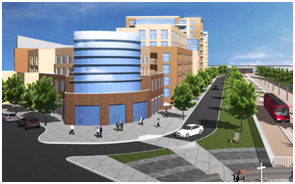By Janis Russell
October 2, 2014 (La Mesa)- At yesterday’s La Mesa Planning Commission meeting, where a hearing on the Park Station specific plan was discussed, the planning commission voted 6-1 to recommend that the La Mesa City Council deny the proposed plan because the commission found the 10-story height inconsistent with the city’s general plan.
Before the hearing began, Chair Noah Alvey welcomed Jim Newland, who replaced Harold Bailey as commissioner.
This hearing drew a crowd that spilled out the doors. Co-applicant South Baltimore LLC replaced the American Legion, which withdrew its support.
Chris Jacobs from staff gave an update to the Commission. “The specific plan proposes development of the mixed use urban village on a 4.75 acre site,” he said, adding that the

test plan proposed also included revisions made from June to August this year. There would be 363 dwelling units, 250 guest rooms for the hotel, and 61,000 square feet of commercial space among other changes.
That’s scaled back from the original 18 stories proposed, which was initially to include a hotel in addition to a convention/meeting facility, residential, retail and commercial space.
The key question presented to commission was: Would a ten story building fit into the neighborhood context?
Like last time, there were two significant unavoidable impacts- aesthetics/visual impact and air quality/greenhouse gas emissions.
Staff recommended that the commission determine if the EIR adequately addressed all potential impacts and meets the requirements of CEQA. If the EIR is found to be adequate, staff recommended that the planning commission recommend the proposed plan to city council. A draft resolution was presented to the commission with recommended project conditions for approval.
When commissioner George Hawkins wanted to know how this revised project differed from the one in June, Jacobs explained, “The size of the subject property was reduced… Density is the same 80 units/acre.”
A total of 35 speakers came, most of whom were against the project. Those who were in favor spoke first.
Sherman Harmer from Urban Housing Partners presented the commission with more details. “In 2004, there was a booming housing market…Andy Kitzman wanted to leave a legacy [and] hired Urban Housing Partners.” A survey was then given to La Mesa residents, and the consensus was a community center with a hotel, space for meetings/weddings/parties. Harmer would later explain that this survey was conducted six years ago, in which 800 people in La Mesa were interviewed by telephone. In October 2008, an application was submitted to La Mesa with American Legion as a co-applicant. From 2009 to 2013, La Mesa managed preparations of the EIR report.” The Kitzman family also deposited a good amount of money to help fund the project. Move San Diego endorsed them. “In 2013, due to public concerns, the height was lowered from 190 to 110 feet (where the hotel would be). The co-applicant from American Legion withdrew their application.” The dwelling units went down from 416 to 363.
Michael Dunham from Urban Housing Partners continued the presentation, also adding they were prepared to change parking spaces from 1 per unit (363 stalls) to 1.25 per unit (453 stalls).
Lenette Hewitt from Urban Housing Partners discussed the seven years of community input that was involved. There were 400 supporters/interested parties who live at Park Station, want to have a business, that want new shopping/dining options, and who would like Park Station to be a catalyst to revitalize downtown La Mesa. “A majority of them live in La Mesa,” Hewitt noted .
Frank Kitzman, whose family owns the property, was next to speak. “We’re doing this a second time… Our family has been in La Mesa for over 100 years.” He also mentioned his family still owns a number of properties and would still like to continue on this project.
Joseph Kitzman (photo, left) then shared his views. “We’ve been here for four generations… Growth happens no matter what.”
Tim Taylor, a resident, said that he has worked with the applicant before and he is in support.
Jacob Schwartz from Urban Housing Partners said, “I was very happily involved in the public outreach.” After talking with the community, he had believed that the younger generation “absolutely loved our project” and the older generation didn’t.
Stephen Gaspar, a resident, chose to state in writing that he was in support.
Brian Sack from the La Mesa Chamber said, “We are hopeful all parties will see this through… [It’s] good for growth and overall betterment in the city of La Mesa.”
La Mesa resident Jim Stone was also in favor. He also represented Move Alliance and executive director of Circulate San Diego. “We can’t keep building out on suburbs; it’ll create more traffic… This is improving the quality of life.”
Then those in opposition shared their opinions.
Craig Maxwell from Maxwell’s House of Books told the commission, “I’m in the village every day..The feedback I’ve gotten has been uniformly negative” from talking with the community.
Julie Sutton-Hayes has also spoken with La Mesa residents. “Nobody likes it… [It’ll create a] traffic nightmare… La Mesa has always been exceptional at preserving the quality of life.”
Kristin Kjaero stated, “Until we have a structure in place, to double the density doesn’t seem appropriate.”
JR Morgan said, “We’ve seen a display of several contrasting views.” He suggested that flags/poles be put up for measuring purposes.
George Morgan showed different pictures including where the 9-10 story building blocks Mt Helix. “I don’t want to see 10 stories here [or] anywhere in La Mesa.”
Bill Adams had arrived late, but he wrote a letter that another resident Aaron Amerling read aloud. Amerling then shared his views. “[La Mesa] has a small town feel (without living in a condo).” He also expressed other details about the project he was against.
Mary Earnert told the commission she spoke at the June meeting and wouldn’t repeat what she had said. She then added, “It’s a shame [there has been] antagonistic views; this could become a win-win. I got the sense that if you were opposed to the height, you were opposed to the whole project… I would implore you that my issue is with the height. Ten story height is inappropriate for the fabric of community.”
Janet Bock said she’s normally one to look at both sides of an issue before making a decision. Now that she’s seen both sides of this issue, she’s against the project. “A high rise in La Mesa would be wrong… La Mesa is so quaint and wonderful.”
Suda House was also against the 10 story height. “No more than 4 would be perfect,” House said.
Laurise Gerk argued that this plan wasn’t a real plan. She also had a problem with the parking request. “La Mesa would no longer be a small town.”
Aaron Davis, who’s one of the younger generations mentioned he has a three year old. He works at Scripps Institute as an engineer. “I’m not for this project at all… There’s already a traffic problem in this area.”
Amy Amerling, who has lived in La Mesa for three years, told the commission that she had moved to La Mesa for its small town feel. She also felt that keeping the height at 4 feet would be good.
Del Williams also mentioned about the existing traffic problems.
Charles Bras mentioned he had the opportunity to review the EIR and specific plan. He suggested to the commission to just listen to all the speakers.
Harold Bailey, who was on the planning commission, spoke. He said that eight stories would be consistent, and suggested to have no cars on the plaza and to keep it pedestrians only.
Mary Jane Bailey said, “I like the idea of re-development [but] I do not support the 110 foot building.”
Michael Blaksley, who doesn’t live anywhere close to where some areas in La Mesa are affected, argued, “La Mesa’s my backyard… No one wants to see dreams or legacies stopped [but] when is enough enough? I live here because of the quality of life La Mesa brings me,” he added, “Four stories is enough.”
Dorothy Ward told the commission that she was interested to hear the presentations from those in favor. Then, when she heard the opposing views, she said, “They were even better… La Mesa will be so congested.”
Lili Feingold, who has been away for 19 years and just recently came back to La Mesa last year, argued, “To me, it looks like a giant human ant farm… I live in downtown La Mesa because it’s quaint, it has charm and character. With no disrespect to proponents, there’s a level of arrogance.”
Harper then made a rebuttal. “Height has become a major, major issue. [We’re] prepared to discuss a compromise, to commit ourselves to change the height from 110 feet to 85 feet (at the backside eastside and Baltimore would still be at 46 feet)… Regarding parking, we would add 90 parking stalls (to 1.25/unit). We’ve spent 9 years trying to do the right thing… We want a win-win for the city.. for the Kitzmans, [and] for the citizens.” He also added that there would be no change in density; there could still be 80 dwelling units in an eight story building but with smaller units. That height however would still be double the city’s current height limit.
Assistant city attorney Greg Lusitana clarified that the commission would make two decisions- one on the Environmental Impact Report (EIR) and whether it's adequate and meets requirements of CEQA, and a decision on the plan itself.
When Alvey suggested deliberating on the EIR and specific plan, and removing the project from the plan, Hawkins didn’t want to do that. “I can’t consider the view…I’m still not sure about the height,” Hawkins said, reminding everyone that the final decision is up to the City Council.
Lusitana explained the three options the commission could go forward with: 1) approve the EIR, 2) find something wrong with EIR, hold a public hearing again and address it, or 3) deny the EIR completely.
Commissioner Dexter Levy thinks they could approve the EIR, but he won’t approve the changes made to the downtown specific plan. “I like it just the way it is.”
Commissioner Janine Hurd-Glenn agreed with Levy.
Community development director Bill Chopyk reminded the commission of the public workshop they conducted regarding the Park Station project probably held in May 2013. It was about updating the downtown specific plan, which is still in process. Currently, there’s a park station project specific plan on its own.
Alvey agreed with Hurd-Glenn. “Removing the site from the plan could be problematic.” Hawkins wanted an explanation of that. Alvey explained to him that it wouldn’t be the same without the site there. “It’s like removing a section out of a whole thing.” Alvey was also concerned this would draw tenants out of the village on the applicant’s specific plan.
Newland thought they should be careful of the project not being consistent with the general plan.
Hawkins made a motion to approve the EIR. Hurd-Glenn seconded. The vote was 6-1 with Vice Chair Michele Hottel against.
Hurd-Glenn recommended disapproving the project as presented and lending support behind the existing general plan. In other words, the commission was saying that the proposed project was inconsistent with the general plan, and they recommended that the City Council deny the specific plan Park Station sought. Then, a motion was made about the current 10 story building and the Park Station specific plan. Levy seconded. The vote was 6-1 to recommend that Council deny approval, with Hottel voting no.
For more information about Park Station project, visit: http://www.cityoflamesa.com/index.aspx?nid=969.













Recent comments